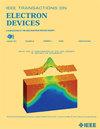考虑温度依赖性的绝缘柱超结比导通电阻优化
IF 3.2
2区 工程技术
Q2 ENGINEERING, ELECTRICAL & ELECTRONIC
引用次数: 0
摘要
建立了统一的温度相关模型,对绝缘柱超结(IP-SJ) mosfet进行了${R} {_{\text {sp}}}$优化。绝缘柱(i柱)可以是补偿柱SJ (CP-SJ)结构中的固有硅,也可以是氧化柱SJ (OP-SJ)结构中的氧化物,甚至是空气柱SJ (AP-SJ)结构中的空气。对这三种典型结构进行了研究和比较。大量的研究表明,CP-SJ与传统的SJ (C-SJ)结构相比没有任何改进${R} {_{\text {sp}}}$。AP-SJ(单位相对介电常数最低)具有最佳的${R} {_{\text {sp}}}$,特别是具有高BV和窄半单元宽度b,以及较大的漏源极电压(${V} {_{\text {DS}}}$),因为它对JFET效应有较好的抑制作用。对于BV ${=}1250$ V和${b}{=}0.6~{\mu}$ m,理论优化预测在室温下,当${V} {{{\text {DS}} =}5$ V时,AP-SJ的${R} {_{\text {sp}} $降低幅度最大,可达20.5%。研究了温度(T)对优化结果的影响以及温度依赖性的应用。本文章由计算机程序翻译,如有差异,请以英文原文为准。
Optimization of Specific On-Resistance for Superjunction With Insulating Pillar Including Temperature Dependence
Unified temperature-dependent models are developed to optimize ${R} {_{\text {sp}}}$ for the insulating pillar superjunction (IP-SJ) MOSFETs. The insulating pillar (i-pillar) could be intrinsic silicon in the compensated pillar SJ (CP-SJ) structure, oxide in the oxide pillar SJ (OP-SJ) structure, or even air in the air pillar SJ (AP-SJ) structure. These three typical structures are investigated and compared. Extensive investigations reveal that CP-SJ exhibits no improvement ${R} {_{\text {sp}}}$ compared with the conventional SJ (C-SJ) structure. The AP-SJ (with the lowest relative dielectric constant of unity) possesses the best ${R} {_{\text {sp}}}$ , especially with high BV and narrow half cell width b, and large drain-to-source voltage ( ${V} {_{\text {DS}}}$ ), due to better suppression of JFET effect. For BV ${=}1250$ V and ${b}{=}0.6~{\mu }$ m, theoretical optimization predicts a largest reduction up to 20.5% in ${R} {_{\text {sp}}}$ with ${V} {_{\text {DS}} =}5$ V for the AP-SJ at room temperature. The effects of temperature (T) on the optimization results and the temperature-dependent application are also investigated.
求助全文
通过发布文献求助,成功后即可免费获取论文全文。
去求助
来源期刊

IEEE Transactions on Electron Devices
工程技术-工程:电子与电气
CiteScore
5.80
自引率
16.10%
发文量
937
审稿时长
3.8 months
期刊介绍:
IEEE Transactions on Electron Devices publishes original and significant contributions relating to the theory, modeling, design, performance and reliability of electron and ion integrated circuit devices and interconnects, involving insulators, metals, organic materials, micro-plasmas, semiconductors, quantum-effect structures, vacuum devices, and emerging materials with applications in bioelectronics, biomedical electronics, computation, communications, displays, microelectromechanics, imaging, micro-actuators, nanoelectronics, optoelectronics, photovoltaics, power ICs and micro-sensors. Tutorial and review papers on these subjects are also published and occasional special issues appear to present a collection of papers which treat particular areas in more depth and breadth.
 求助内容:
求助内容: 应助结果提醒方式:
应助结果提醒方式:


